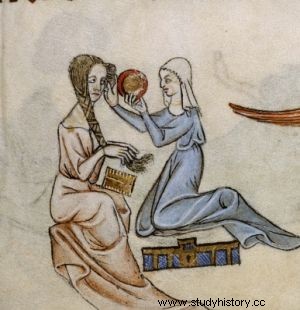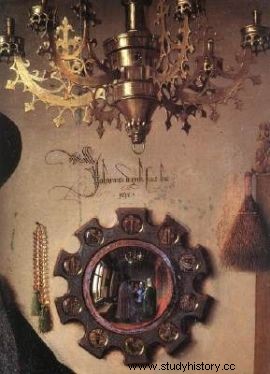It is hard to imagine a Renaissance without glass mirrors. Could a man begin to think of himself as an individual if he were not able to see his own face? Could he "invent" humanism and individualism? Of course, it was always possible to look in the pond or use a mirror made of polished metal. However, it was only glass mirrors that meant a real revolution. Surprisingly, there is not much information about her in the historical sources.

A lady at the toilet with a maid holding a mirror. An English manuscript from around 1325-1335
It's hard to imagine a Renaissance without glass mirrors. Could a man begin to think of himself as an individual if he were not able to see his own face? Could he "invent" humanism and individualism? Of course, it was always possible to look in the pond or use a mirror made of polished metal. However, it was only glass mirrors that meant a real revolution. Surprisingly, there is not much information about her in the historical sources.
The Middle Ages took over the legacy of metal mirrors, initially only diversifying their shapes. These types of items had been known for thousands of years and were of no novelty, although they were mainly used at courts and in the upper classes. An indispensable element of the lady's outfit was a small pocket or hand mirror, worn either at the waist or hung around the neck. As early as the early Middle Ages, extremely expensive, richly ornamented mirrors were made, following the example of a bygone era. The silver mirror was sent by Pope Boniface IV as a gift to the Queen of Northumbria Etelberg. Other expensive mirrors can be found in the inventories of royal and princely treasuries all over Europe. All these were mirrors, however, not resembling those we know today . To a very limited extent, they fulfilled their basic role, that is, they reflected the silhouette of the person looking at them. Only glass mirrors were supposed to bring a change.

Hand-held mirror on a painting from the beginning of the 16th century.
Theophilus, a Benedictine monk who wrote a 12th-century handbook on craftsmanship, details the various uses of glass in detail, but knows nothing about making mirrors from such material. Likewise, Roger Bacon, writing in 1266, limits himself to bronze, steel, and silver mirrors. Yet another author, in a work from the end of the 13th century, calls the mirror-making workshop a "forge", which leaves no doubt as to the material used.
Meanwhile, already in the 15th century, the availability of glass mirrors seems to be obvious. In Germany, convex glass mirrors called Ochsenaugen were produced at that time. - "with free eyes". They were made of glass spheres filled with a mixture of tin, antimony and resin, which, after cooling down, were cut into small lenses. They were not very accurate mirrors, and their small size limited their uses, but they could be made quickly, relatively cheaply, and in large quantities. A mirror, at least a pocket mirror, was slowly becoming a generally available product. In the fifteenth century, round mirrors made of blown glass also appeared, in a considerable number, in the houses of Krakow patricians. In the west, especially in the Netherlands, at that time people liked large wall mirrors. They did not reach us until the Renaissance. In the 13th century, craftsmen knew nothing about glass mirrors. In the 15th century, anyone with a slightly more rich purse could have them. How did this rapid transformation come about and where did the new invention come from?

The mirror quickly became a motif in art. Here the portrait is shown as a reflection in a mirror (1434)
It is known that in 1383 a guild of craftsmen producing glass mirrors existed in Nuremberg. Similar, but almost 100 years earlier, information comes from Italy:already in the first years of the 14th century (if not earlier), craftsmen from Murano near Venice knew the technique of constructing mirrors from glass coated with lead. Literary sources confirm this mention. In Dante's Divine Comedy, we can read about lead-lined glass , and this work was created in the years 1308-1321. However, further sources prove that Theophilus and Roger Bacon did not know the invention that must have existed in their time. The French writer and friar Vincent of Beauvais wrote around 1250 that mirrors made of glass and lead are the best of all, because glass, thanks to its transparency, perceives rays better . It has been shown that the method of making sheet glass mirrors was known before 1200, although it was rarely used and few craftsmen knew about it.
Mieczysław Wallis, the author of the book "Dzieje zwierciadła", published in 1973, closes his argument. In his opinion: the early Middle Ages used almost exclusively metal mirrors. Arabic textbooks from the turn of the 10th and 11th centuries know only steel and silver mirrors . Most likely she is not entirely right. More recent research shows that it was in the Muslim-controlled areas of Spain that glass mirrors were first made in the Middle Ages - already in the 10th-11th centuries, I believe. Kasem Ajram writes about it in his book The Miracle of Islam Science. It is impossible to find such early examples of the use of glass mirrors in Christian Europe. So it was probably from the Muslim world that this revolutionary invention came to us.
Is this the end of this story? Almost. Finally, it should be mentioned that all these medieval adventures took place ... almost a thousand years after the invention of the glass mirror. Such mirrors were reportedly first used by the Romans of Sidon in the first century CE. (now Lebanon). They were mostly small pocket mirrors - similar to the ones that became popular in Germany fifteen centuries later.
Sources:
Basic:
- Mieczysław Wallis, The history of the mirror and its role in various fields of culture , Publishers of art and film, Warsaw 1973, pp. 31-33.
Complementary:
- Kasem Ajram, The Miracle of Islam Science , Knowledge House Publishing, 1992.
- Mark Pendergrast, Mirror mirror:a history of the human love affair with reflection Basic Books, 2004.
- Mirrors, [in:] Medieval &Renaissance Material Culture.
- The Book of the Mirror. An Interdisciplinary Collection exploring the Cultural Story of the Mirror, Edited by Miranda Anderson, Cambridge Scholars Publishing, n.d.w.
